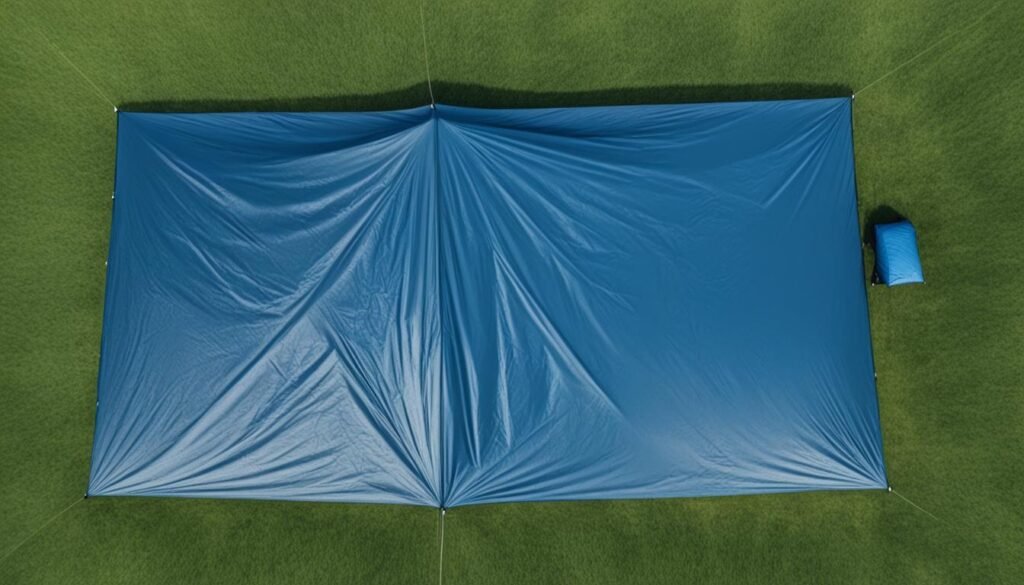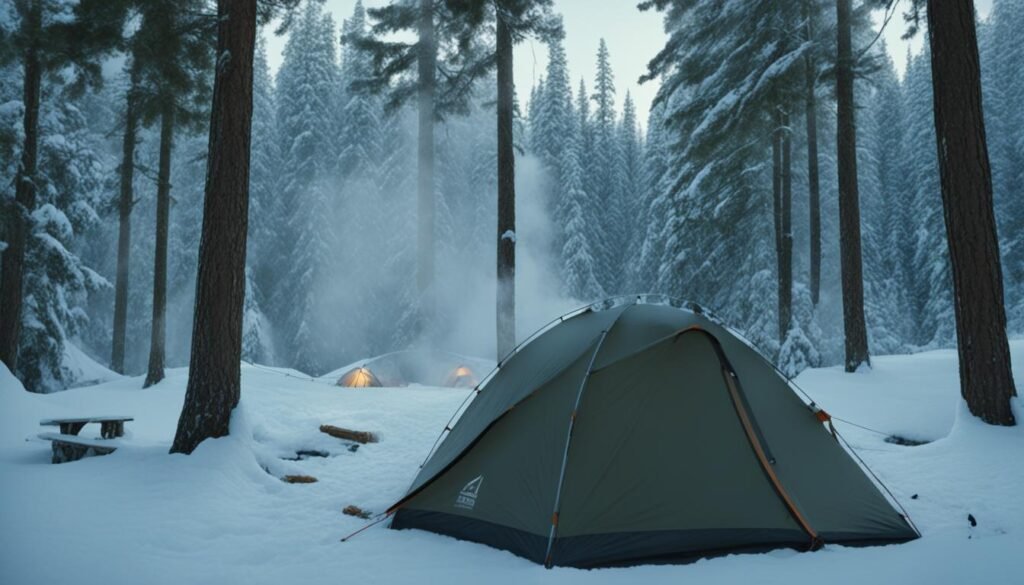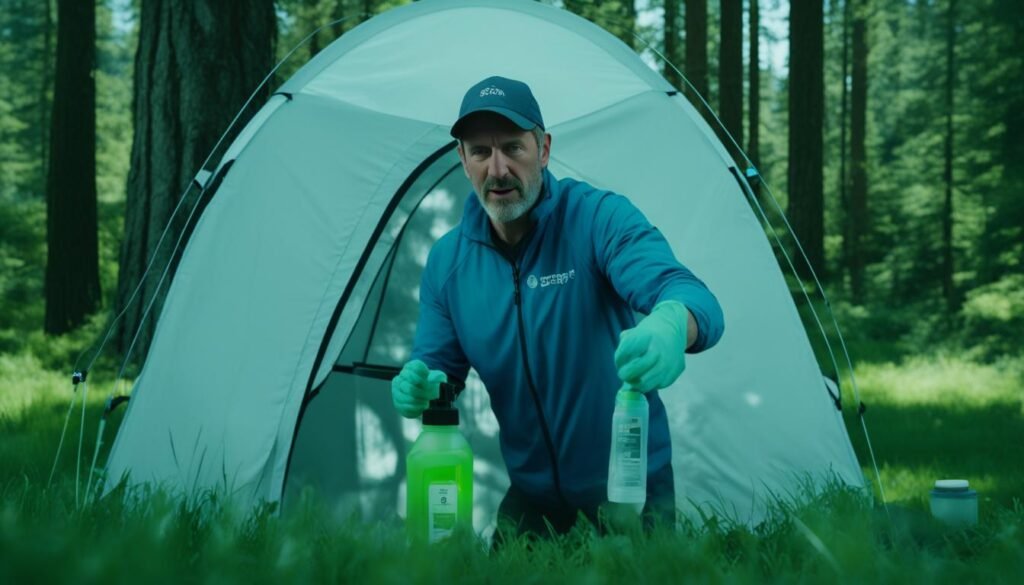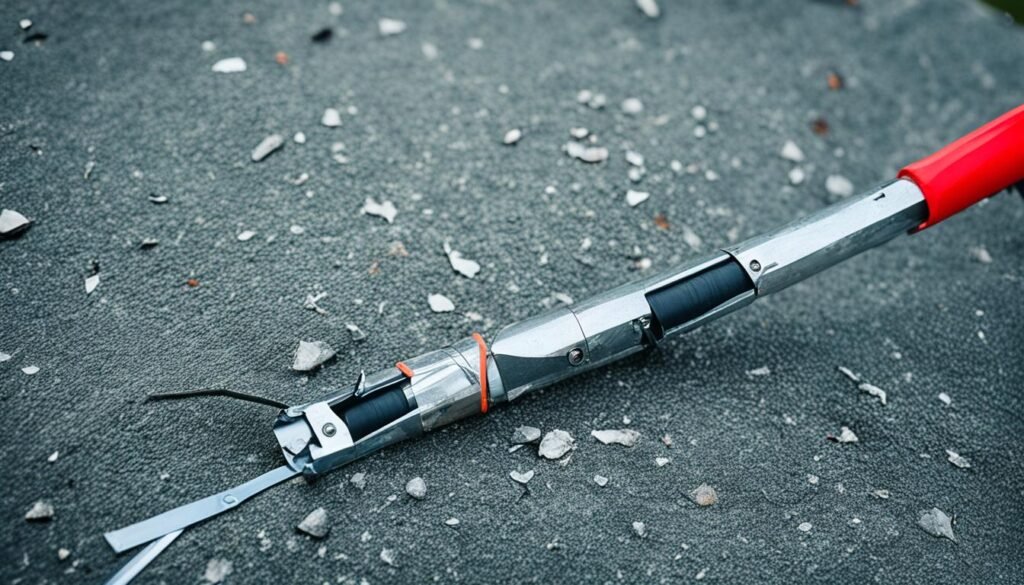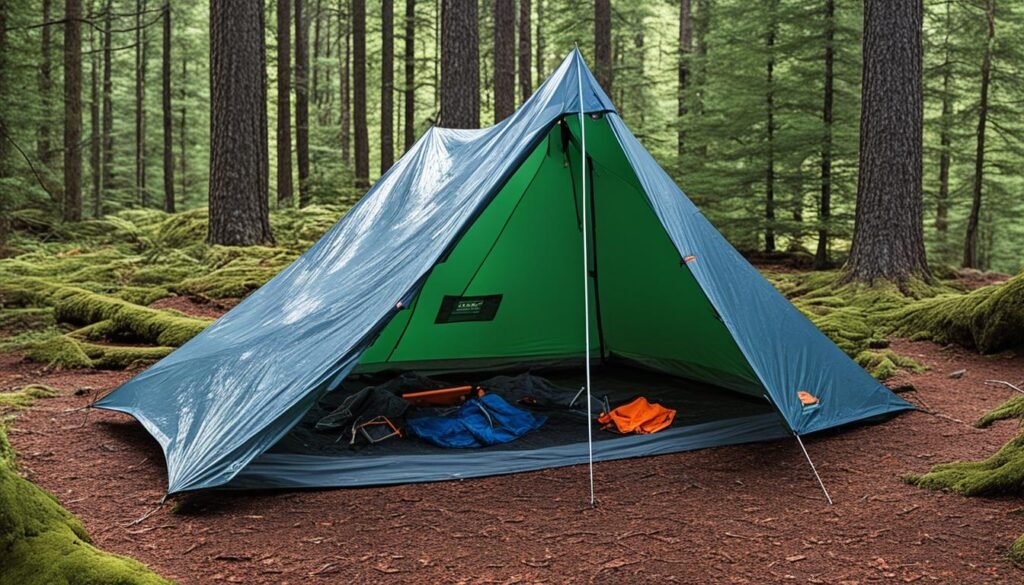You will get tips and techniques on how to stake a tent for a stable shelter in any terrain. This is important for both experienced campers and new adventurers.
Setting up a tent requires careful consideration. You must match the right tent stakes to different grounds. Choosing suitable designs and materials is crucial to prevent your tent from flying away or collapsing.
This guide will show you everything you need to know about tent staking. We’ll cover:
- Understanding different substrates and matching stakes to them
- Choosing the right tent stakes for your needs
- Exploring different tent stake designs
- Examining the pros and cons of tent stake materials
- Providing tips for properly setting up your tent
By the end of this guide, you’ll know how to stake your tent confidently. This will ensure a safe and comfy camping experience. Let’s dive in and learn how to stake a tent!
Key Takeaways:
- Proper tent staking is crucial for a stable and secure outdoor shelter.
- Understanding different substrates and matching the right tent stakes to them is essential.
- Choose the tent stake material and design based on your needs and the ground conditions.
- Follow step-by-step instructions for setting up your tent to ensure its stability.
- Consider additional anchoring methods and tips for challenging terrains or weather conditions.
Understanding Different Substrates and Matching Stakes to Them
Staking a tent right depends on knowing the ground beneath. There are many terrains like rock slabs and sandy soils. Each needs its own way to anchor your tent.
Finding the correct stake for the ground is key for tent stability. Choose the right tent stakes, and you avoid tents that fall or move.
Now, let’s look at which stakes best fit different grounds:
1. Rocky Substrates
For rock slabs and stony grounds, you need strong anchors. Y-shaped stakes or those with a V-shape and hook work best on rocks.
2. Soft Soils
Use longer stakes with a wide V-shape for sandy or loamy soils. They go deeper and stay in loose ground better.
3. Snow and Scree
Snowy or scree areas need special stakes too. Use long ones with a big surface, like snow stakes. They dig in deep for a solid hold.
4. Dense Vegetation and Rooty Soils
In thick green or rooty soil, normal stakes may not work. Use tent platforms or tie your tent to trees for safety.
Knowing which anchor to use for each terrain keeps your tent secure. No matter where you are, the right stake holds your tent tight.
Choosing the Right Tent Stakes for Your Needs
Choosing the right tent stakes is key for a secure shelter. Different materials have their pros and cons. These include strength, durability, and weight.
Titanium tent stakes are well-liked because they are strong yet light. They’re perfect for those who want to keep their pack light but still have a stable tent. Titanium stakes also resist corrosion, lasting a long time in any weather.
Aluminum tent stakes are light, cheap, and fairly strong. They don’t rust, making them good for different places. Campers love them because they are easy to use and won’t break the bank.
Stainless steel tent stakes offer the most durability and strength. They’re great for tough places or bad weather. Although they are heavier than titanium or aluminum, they last a long time and are reliable.
Tent Stake Material Comparison
| Tent Stake Material | Advantages | Disadvantages |
|---|---|---|
| Titanium | Excellent strength-to-weight ratio, corrosion-resistant, lightweight | Higher cost |
| Aluminum | Lightweight, affordable, resistant to corrosion | Less durable than titanium or stainless steel |
| Stainless Steel | Highly durable, strong, suitable for rugged terrains | Heavier than titanium or aluminum |
When picking tent stakes, think about where you’ll camp, the weight you can carry, and your budget. Thinking about these things will help you choose the best stakes for your tent.
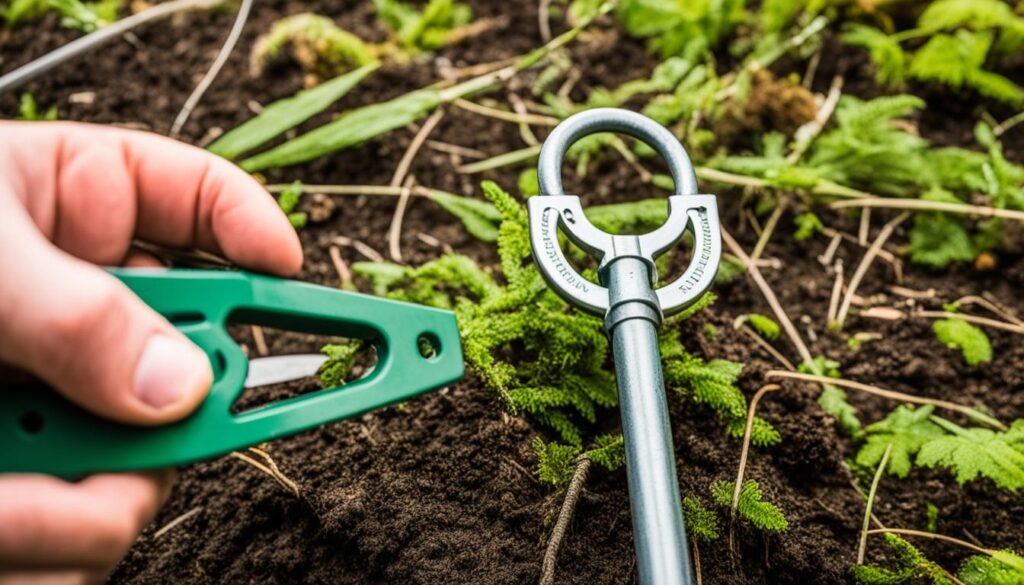
Exploring Different Tent Stake Designs
Tent stakes come in many shapes, each with unique pros and cons. Knowing the differences helps pick the right one for your camping needs.
Tent stakes vary in Y-shape, V-shape, pin, and hook designs. Each type is best suited for specific terrains. Let’s look closely at these designs:
Y-shape tent stakes
Y-shape stakes are versatile and reliable. They have three arms for strong grip in various soils. This makes them stable for many camping spots.
V-shape tent stakes
V-shape stakes work best in soft, sandy soil. They look like “V” from above. Their edges dig in easily, keeping tents steady in wind.
Pin tent stakes
Pin stakes are thin and good for backpacking. They’re easy to push into the ground. But, they may be less stable in rough weather or terrain.
Hook tent stakes
Hook stakes, or shepherd’s hooks, are good for hard or rocky ground. Their curved shape helps grip uneven surfaces. They’re also easy to pull out.
When choosing stakes, think about the ground. Y-shape and V-shape stakes are good for most places. Pin stakes are easy to carry but not always stable. Hook stakes work well on rocky ground.
Knowing the types of tent stakes helps pick the best for your trip. This ensures your shelter stays secure.
The Pros and Cons of Tent Stake Materials
Choosing the right tent stakes is crucial for outdoor fun. Each material, like titanium or plastic, has pros and cons. Knowing these can help you pick the best one for you.
Titanium Tent Stakes
Titanium stakes are light but very strong. They work well for backpackers. They don’t rust and last long. But, they cost more than others.
Aluminum Tent Stakes
Aluminum stakes are both light and cheap. They’re great for casual camping. But they might bend if the ground is very hard or if there’s a lot of weight.
Stainless Steel Tent Stakes
Stainless steel stakes are very strong. They can handle rough ground and bad weather. They are heavier, so they’re good for camping trips where you bring a car.
Plastic Tent Stakes
Plastic stakes are light, cheap, and easy to use. They often come with budget tents. But they’re not as strong as metal ones. They work best in soft ground.
| Tent Stake Material | Advantages | Disadvantages |
|---|---|---|
| Titanium | Lightweight, excellent strength, corrosion-resistant | Higher cost |
| Aluminum | Affordable, lightweight, easy to carry | Less strong, may deform under heavy loads |
| Stainless Steel | Strong, durable, suitable for tough conditions | Heavier, may be overkill for lightweight camping |
| Plastic | Lightweight, inexpensive, easy to use | Less robust, more prone to damage |
Tips for Properly Setting Up Your Tent
Setting up your tent right is key for comfort and stability outdoors. Here are steps and tips for setting up your tent the right way.
1. Choose a Suitable Campsite
Pick a flat campsite without debris and away from dangers like uneven ground. Also, think about water access and privacy from other campsites.
2. Lay Out the Tent
First, unfold your tent on the ground. Make sure it faces the way you want and that the rainfly is within reach.
3. Assemble the Frame
Build the tent frame by following the instructions. This might mean connecting poles and securing them, depending on the tent type.
4. Expand the Frame
With the frame built, lift and open the tent so it shapes up. Check that the fabric is tight.
5. Adjust the Height of the Legs
Make sure the tent legs are even for balance and stability. You can change the length of most tent legs.
6. Stake Down the Tent
Stake your tent into the ground using the right stakes for your campsite. This makes your tent stable.
Pro Tip: Hard or rocky ground needs special stakes, like rock stakes or sand anchors. They help your tent stay put.
7. Attach the Rainfly and Guylines
Put on the rainfly for weather protection. Also, use the guylines to keep your tent steady in the wind.
Expert Advice: For more on setting up tents, check out the AMC Outdoors tent pitching guide. It has tips for various tents and situations.
Follow these instructions and tips for a good tent setup. This ensures your tent will be stable and safe during your outdoor adventures.
| Tent Setup Tips | Benefits |
|---|---|
| Choose a suitable campsite | Ensures level ground and avoids potential hazards |
| Lay out the tent correctly | Prevents confusion and improves setup efficiency |
| Assemble the tent frame | Forms the basic structure of the tent |
| Expand the tent frame | Maintains fabric tension and stability |
| Adjust the height of the legs | Ensures even weight distribution |
| Stake down the tent | Provides anchorage and stability |
| Attach the rainfly and guylines | Enhances protection and stability |
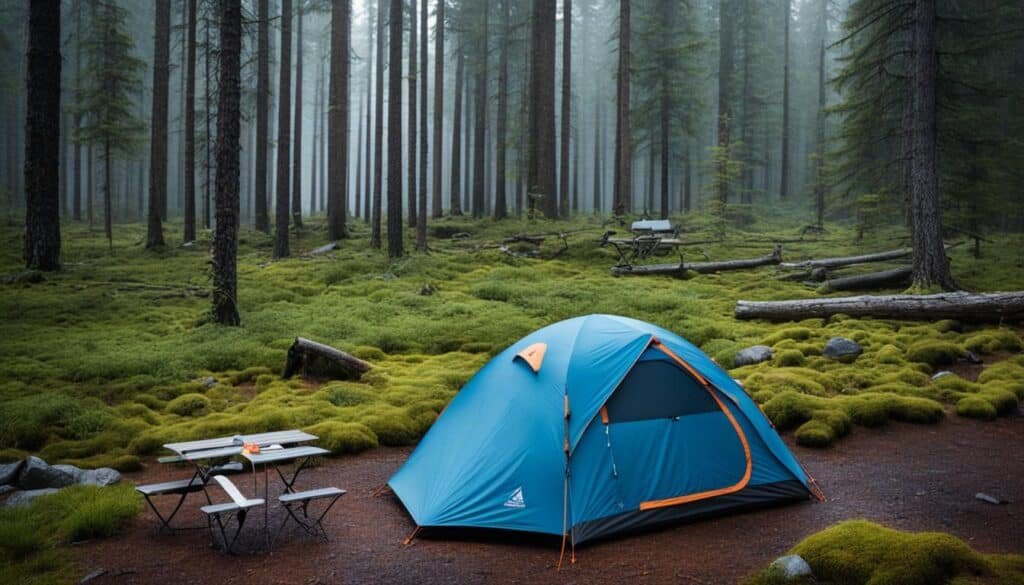
Considerations for Different Terrains and Locations
When setting up your tent, think about the terrain and location. These can greatly affect how stable your tent is. It’s good to know what to consider for different places.
Tent Setup on Sandy Ground
Camping on sandy ground needs special steps. First, remove any sand or debris where you’ll put your tent. Use stakes made for sand so your tent stays put. Deeply bury the stakes for more stability.
Tent Setup on Rocky Ground
Choosing the right stakes is key on rocky ground. Look for strong stakes made for this terrain. Y-shaped or V-shaped stakes work best. Use a mallet to anchor them well. Avoid hitting the stakes against rocks to prevent damage.
Tent Setup on Concrete or Asphalt Surfaces
Camping on concrete or asphalt is different. Instead of stakes, use sandbags or weights to hold your tent. Attach guylines to the anchors. Use a groundsheet for insulation and surface protection.
Securing your tent well in various places is key for a good camping trip. Picking the right stakes or weights makes your shelter stable and lasts longer.
Before camping, research the terrain and location. The REI Expert Advice website has tips for different camping situations.
Tent Setup on Other Terrains
There are many other terrains like forests or snowy areas. Assess each place carefully to make your tent stable. Happy camping!
| Terrain | Considerations |
|---|---|
| Forest Floors | Avoid setting your tent over tree roots or dense plants. Choose a flat spot. Use suitable stakes for the soil. |
| Snowy Landscapes | In snow, make strong anchors. Use snow stakes for a secure hold. This keeps your tent from being blown away. |
| Other Terrain Types | For unique terrains, look up specific anchoring tips. Gear experts and seasoned campers have useful advice. |
By thinking about the terrain and location, you can make your tent stable and safe. Always follow the tent setup guide. Enjoy your camping!
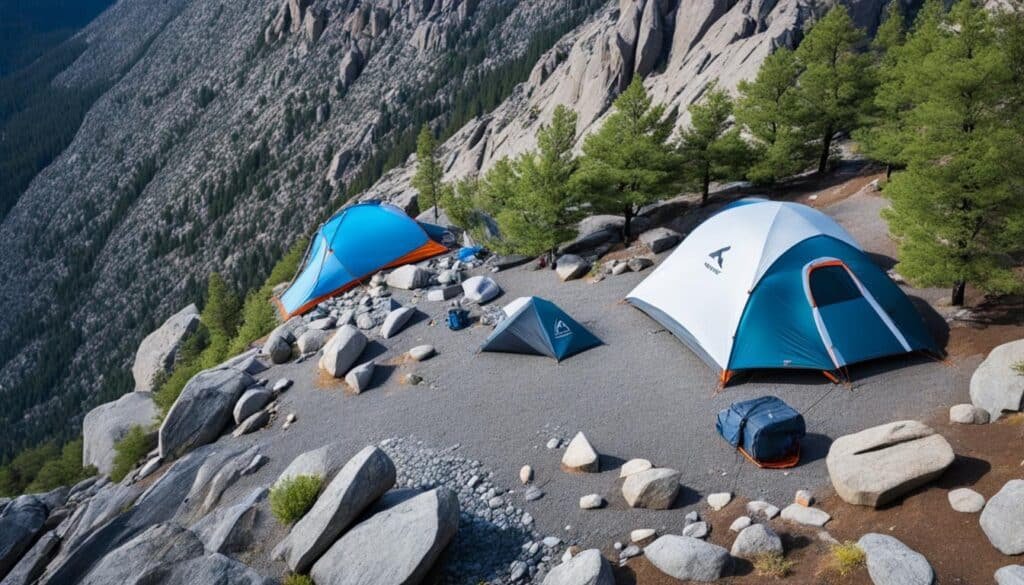
Using Additional Anchoring Methods for Extra Stability
When the weather is windy, taking extra steps for your tent’s stability is smart. Traditional stakes are good, but more can be done. Other anchoring ways add extra stability.
Tent anchors are made to keep your tent secure in tough conditions. These heavy-duty stakes grip the ground well. They help prevent your tent from being blown away.
Using additional anchoring methods like straps and ropes is also great. These offer more strength and reliability. So, you won’t worry, even if the weather gets bad.
“Using tent anchor straps and tie-down ropes makes your tent more stable. They give extra support and stop your tent from moving or falling, even in strong winds or on rough ground.”
Tent anchor straps are strong and have adjustable straps. You attach them to things like trees or rocks. They create tension, holding your tent in place against the wind.
Tie-down ropes are another good choice for more anchoring. They are light and easy to carry. You secure them to the tent with loops or grommets. When tightened and attached to something sturdy, they add stability and stop your tent from moving or lifting.
It’s wise to think about where you’re camping when choosing anchoring methods. In sandy places, you might need longer straps for a good hold. For rocky areas, ropes might be better because stakes can be hard to use.
Benefits of Using Additional Anchoring Methods:
- More stability and security for your tent
- Lower chance of your tent collapsing or moving
- Better resistance to strong winds and bad weather
- The ability to deal with different grounds and camping situations
- Feeling calm and ready for outdoor fun
Adding things like tent anchor straps and tie-down ropes to your gear helps keep your tent stable and safe. This means you can enjoy the outdoors without worrying about the weather.
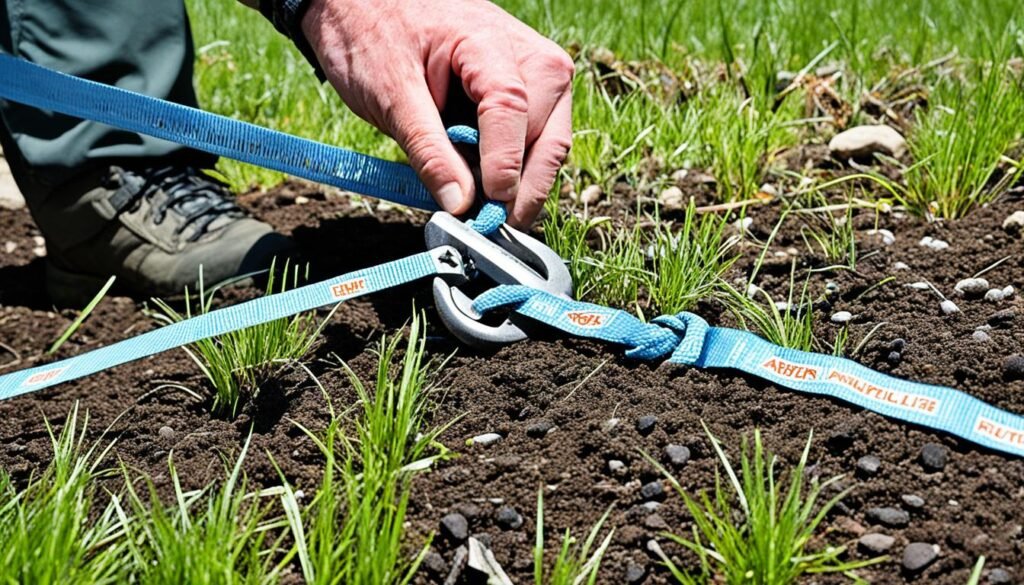
Tips for Anchoring in Challenging Environments
When anchoring your tent, you may face challenges like dense vegetation or uneven ground. Traditional stakes might not always work well. Here are some tips to anchor your tent well:
- Utilize alternative anchoring methods: In places with lots of plants, usual stakes might not go into the ground. You might want to use tent anchor straps instead. They can wrap around trees or big branches. This helps hold your tent in place, even in thick vegetation.
- Create a tent platform: In areas with lots of roots or uneven ground, it’s hard to find good spots for your tent. Making a tent platform can help. Clear away any roots or debris. Then lay a tarp or groundsheet down for your tent. This makes a stable place for your tent and a flat space for sleeping.
- Use longer stakes: For places with lots of roots, longer stakes work better. They can go deeper into the ground. This helps avoid the roots and gives your tent a solid hold. Use stakes that are at least 10 inches long for rooty places.
- Secure your tent with guy lines: In tough places, it’s good to use multiple points to hold your tent. Attach guy lines to the tent’s corners. Then extend them out and anchor them to trees or something strong. This spreads out the force and adds extra stability. It’s helpful when usual stakes don’t work.
When you’re in tough spots, being creative and flexible helps anchor your tent. Use different methods, build platforms, pick longer stakes, and use guy lines. These steps will help keep your shelter steady, even when it’s hard.
Quote:
“In tough spots, the steadiness of your tent depends on smart anchoring and adjusting. Don’t hesitate to use new ways to keep your shelter steady. And enjoy a calm night’s sleep.” – Outdoor Enthusiast
| Challenging Environments | Anchor Methods |
|---|---|
| Dense Vegetation | Tent anchor straps |
| Tent Platforms | Create a level surface using a tarp or groundsheet |
| Rooty Substrates | Longer stakes or alternative anchoring methods |
Maintaining and Caring for Your Tent Stakes
It’s key to keep your tent stakes well-maintained for their best performance. Following simple steps will help. This ensures they last long for many camping trips.
Cleaning Tent Stakes
Clean your tent stakes after every trip. Use a soft brush or cloth to wipe away dirt. Focus on the parts that go into the ground.
For steel or aluminum stakes, mild soap is okay. Don’t use strong cleaners. They can harm the stakes.
Rinse them with water and dry them well after. Wet stakes can rust or corrode. Make sure they’re completely dry before you store them.
Inspecting Tent Stakes
Checking your tent stakes regularly is a must. Do this before you go camping. Look for any damage like bends or cracks.
If they’re damaged, it’s best to get new ones. Always have extra stakes for emergencies.
Storing Tent Stakes
How you store stakes is important for their condition. Clean and dry them first. Damp stakes can weaken over time.
Keep them in a cool, dry place. Use a stake bag to keep them neat and safe.
Additional Tips for Tent Stake Care
- Don’t force the stakes into hard ground. It could break them.
- Use a mallet or rock for tough ground.
- Keep the lines attached to stakes tight for a stable tent.
Looking after your tent stakes means a steady, safe camping spot. These tips should become a part of your routine. That way, you’ll always know your tent stakes are ready.
| Tent Stake Maintenance Checklist |
|---|
| Clean tent stakes after each use using a soft-bristle brush or cloth. |
| Inspect stakes for any bends, cracks, or sharp edges before each camping trip. |
| Replace any damaged stakes promptly for optimal performance. |
| Ensure stakes are completely dry before storing to prevent rust or corrosion. |
| Store stakes in a dry and ventilated area, away from direct sunlight and extreme temperatures. |
| Avoid using excessive force when driving stakes into the ground to prevent bending or breaking. |
| Regularly check and adjust guy lines or tie-down ropes for a secure and stable pitch. |
Choosing Quality Tent Stakes
Securing your shelter outdoors is crucial. Quality tent stakes are key to this. They ensure stability and safety, even in tough conditions.
It’s important to choose stakes from reputable brands. Such brands are known for making durable, reliable stakes. These can handle different conditions well.
“The quality of your tent stakes can be a game-changer in ensuring a secure and stable shelter. Choosing reputable brands known for their high-quality tent stakes is a wise investment in your outdoor experience,” says outdoor enthusiast and tent stake expert, Mark Thompson.
Consider the design and material of tent stakes. Look for ones made from titanium, aluminum, or stainless steel. These materials last long and are strong.
There are various designs like Y-shape, V-shape, pin, or hook. Each type works best in different grounds. This choice can make a big difference.
Quality tent stakes mean a stable shelter during your adventures. Don’t overlook this crucial part of your camping gear. High-quality stakes make camping better.
To learn more about tent stakes, visit outdoorlife.com. They offer reviews and recommendations. This can help you choose the best stakes.
Conclusion: Mastering the Art of Tent Staking
After learning all about tent stakes, you’re ready. You know how to keep your tent stable on any land now. Follow the advice given to stake your tent right. This way, you’ll stay safe and have fun camping.
We’ve talked about choosing the best stake for the ground. It’s key to pick the right design and material for your stakes. And we’ve shared steps on setting up your tent. We also gave tips for hard spots.
Lastly, always go for good stakes from trusted makers. Take care of your stakes so they last longer and work well. With these tips, you’ll nail tent staking. Now, you can camp comfortably knowing your shelter is secure.
FAQ
What are the different substrates and how do I match the stakes to them?
Different substrates need different anchoring methods. It’s vital to use the right stake for the ground type. Some examples include rock, hard soil, and sand. Each kind has unique anchoring needs.
What types of tent stakes should I choose?
You can choose from materials like titanium, aluminum, and steel for tent stakes. Each one has strengths and weaknesses. Pick based on your needs and what you prefer.
What are the different designs of tent stakes?
Tent stakes vary in design, including Y-shape, V-shape, and others. Each design works best in different conditions. Choose based on the terrain and ground where you’ll camp.
What are the pros and cons of different tent stake materials?
Materials like titanium and others each have pros and cons. Consider strength, weight, and cost. This will help you choose the best stakes for your tent.
How do I properly set up my tent?
Setting up your tent correctly is key for stability. Expand the frame, adjust the legs, and attach the roof. Always follow your tent’s setup instructions.
What considerations should I keep in mind for different terrains and locations?
Your tent’s stability can vary with the terrain. Things like sand or rocky ground need special setup techniques. This ensures a secure tent setup anywhere.
How can I achieve extra stability for my tent in windy conditions?
Extra anchoring can make your tent more stable in wind. Use things like straps and tie-down ropes. They help keep your tent secure in changing weather.
How do I anchor my tent in challenging environments?
Special techniques are needed for tough places like dense vegetation. Follow guide tips for the best stability in these areas.
How do I maintain and care for my tent stakes?
Keep your tent stakes lasting longer with good care. Clean and check them often. Store them right when not in use.
Why is it important to choose quality tent stakes?
High-quality tent stakes ensure a safe and stable shelter. Choose well-known brands for the best stakes. They help avoid problems during your outdoor trips.


